The post 8 Summer Garden Maintenance Tips appeared first on Garden-R.
]]>Whether a gardener prefers to emphasise lush, beautiful flowers and bushes, or uses his or her land to supplement their food diet, gardening provides so many rewards to those who have developed green thumb savvy. Those experienced in garden maintenance and garden design have learned the subtle tricks that can elevate their work to be the pride of their neighbourhood.
Beginners, however, can always use a few helpful tips to get started on a successful planting.
Effective Ways to Keep the Critters Away
The biggest threat to a bountiful and beautiful garden lies in Mother Nature herself. Even in built-up areas, such as the Inner West, Eastern Suburbs, and other areas of Sydney, animals and other pests can destroy months of hard work in as little as one night.
Ground pests can bring both health to the soil, and threats to other parts of the garden. Termites, especially in the northern regions, have voracious appetites. Do not tempt them by leaving wooden tools scattered on the ground near wooden structures, such as pergolas, sheds, or the main house itself. Wood chips and mulch spread too close to structures can have the same, unfortunate effect of attracting unwanted guests.
Those with vegetable gardens have double the worry. Alongside insects, they must also worry about larger animals dropping by for a quick snack or gorging on a big meal. Some in rural areas have surrounded their gardens with high fences using wooden posts and wire. Gardeners can also use chicken wire to cover smaller plants on the ground to protect against hungry birds and mammals.
Keep in mind that not much can protect a garden or its owner against snakes, so always remain vigilant when working.
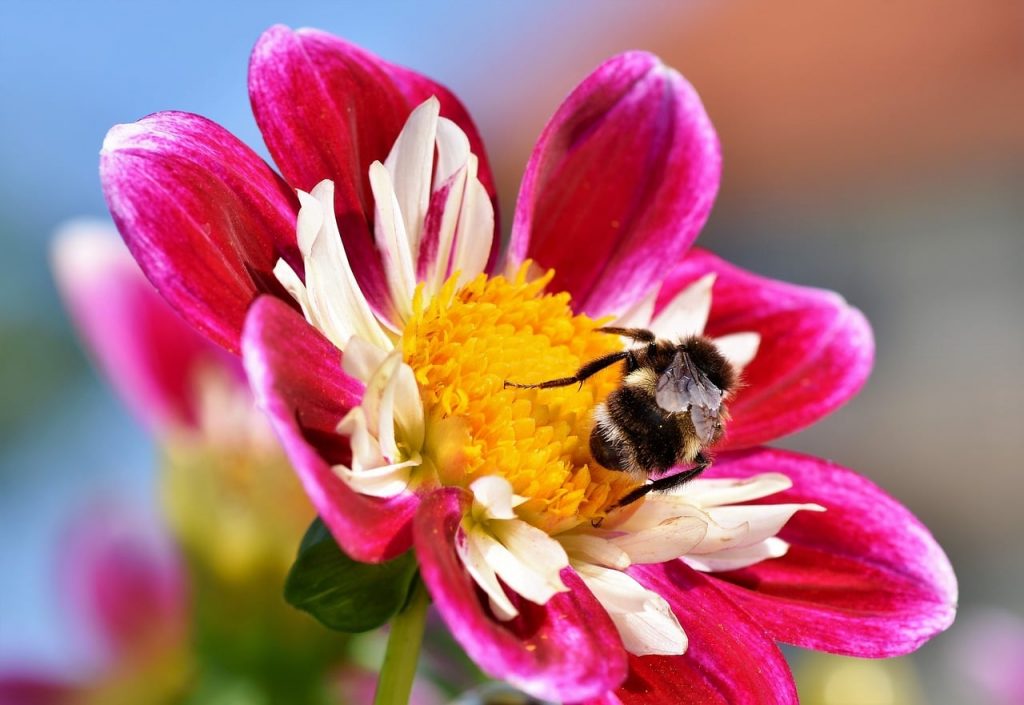
Prune for Plant Health and Beauty
Summertime provides the best opportunity for proper pruning of plants. Smart gardeners research the best time of the summer to prune. For example, many make their New Years’ resolution to prune azaleas and camellias as soon as possible, while roses can wait until February.
Pruning also requires different techniques for different foliage. Fruit trees need regular pruning to keep branches and fruit low to the ground throughout their life cycle. Bush based hedging also requires very specific pruning methods to keep them growing properly.
When to Water
Never, ever water during the middle of the day, especially in high summer. The heat of the day combined with relentless solar radiation provides enough problems, but water on leaves can actually amplify the effect.
Experienced gardeners usually water either in early morning or evening when the sun’s rays no longer have direct impact on foliage. This ensures that the water contributes to plant health instead of harm. Plants also get the full benefit of water soaking into the ground, rather than burning away into the sky as vapour.
Too Much Sun Can Hurt Younger Plants
Speaking of the sun, its potential damage can harm young and recently transplanted plants trying to establish themselves in harsh summer conditions. Make some temporary, but translucent semi-shade for them for the first couple of weeks using whatever materials you have handy. This can include old curtains or sheets. Make sure to allow some direct sunlight, however, as sunlight is essential to plant life.
How to Make Watering More Efficient and Effective
Smart gardeners always try to promote efficiency and effectiveness when working in the garden. One way in which to accomplish this lies in adding nutrients to water before spraying or drizzling on plants and surrounding soil. This promotes plant health and reduces work.
Strategically Shade the Garden
Some gardeners indulge themselves in creating large, sophisticated, and complex garden design schemes. While ambition is always laudatory, those planning such an endeavour need to appreciate the value of researching different plants’ sun tolerance. Planting trees or erecting aesthetically pleasing sun blockers of some other type can ensure that sun-vulnerable plants do not get fried in the summer heat.

Leave Lawns Longer In the Heat of the Summer
Why leave a beautiful and perfect looking piece of outdoor work surrounded by a barren and dry lawn? Gardeners know that they must give their lawns the same care and attention as their gardens to get the same results. When lawn mowing in hot periods, make sure that attention gets paid to keeping the yard healthy.
Although some get tempted by the possibility of having a golf course style yard with grass trimmed short and neat, lawn care experts understand that keeping the grass a little higher than normal can promote resilience in the heat of the summer, keeping grass green and lush.
Gardeners Need to Take Care of Themselves as Well as Their Plants
Yes, a beautiful lawn and garden represent a huge priority for most, but it should never overtake that of personal health. The same stressors that too much heat, sun, and humidity can bring to plant life can affect people even more.
When working outside in the summer heat, make sure to stay hydrated more than usual, and take more frequent and lengthier breaks. While water is best, sports drinks can also provide needed vitamins and minerals. Sodium packed sodas and alcohol have the opposite effect. They dry out the body, leaving it in worse shape during strenuous work on hot days. Make sure to include potassium-packed natural foods when eating to keep those levels high and reduce the possibility of painful cramping.
Also always wear sunblock and protective clothing to protect against painful and harmful burning.
These helpful tips can give the beginning gardener a good handle on protecting the health of their garden and themselves during the summer. As he or she gains experience, the gardener should continue learning through research and observation on how to get the most out of their land.
The post 8 Summer Garden Maintenance Tips appeared first on Garden-R.
]]>The post 7 Tips For Maintaining a Garden in New South Wales appeared first on Garden-R.
]]>Count on the winter months to provide a needed break from the heat, giving people and plants alike some time to recuperate and prepare for the next growing season.
Below are a few tips for getting the most out of your garden throughout Sydney and New South Wales.
Getting Ready for the Season
Spring represents the time for renewal, especially of the garden. Whether or not the garden emphasises flowers, food, or both, the moderate temperatures and climate of spring provide a great opportunity to get essential work done. At this time of year, it will be a less stressful environment for both plants and people than it will be during the hotter summer months.

Fertilise Both the Lawn and Garden
Most start their lawn care, lawn maintenance, and garden maintenance plans in the spring. Some also initiate their garden design schemes during this time of year as well. Plans should start with making sure that the soil has sufficient nutrients to form an ideal foundation for plant health.
Unfortunately, many of the soils in New South Wales have the same issues as those in other parts of the country. These include too much salt and too few nutrients. Experts urge that gardeners use a moderate amount of fertiliser when preparing the soil for planting and growth. Too many nutrients can be hard on plants. They can also run off into streams as damaging bio pollutants.
Check with local experts who can give advice on what to do with soils rich in clay or that have other issues. Proper and precise use of nutrients can help the garden provide the best yield of food or flowers.
Do Not Forget the Evergreens
Evergreen trees and bushes appear more robust than most other trees or plants. While in most cases, this perception reflects reality, they also need care to grow properly and thrive. Increased sunshine in the springtime causes evergreens to pull more moisture from the ground. If not properly watered, the soil around the roots will dry up. In extreme cases, needles can brown and the tree itself may die.
A little consistent watering early in the season can help make sure that the tree thrives the entire year through.
Plant Perennials and Other Plants Soon After the Last Frost
An essential ritual of spring gardening in New South Wales and elsewhere lies in the planting of the garden. Savvy gardeners know that every spring has a rhythm all its own, though. Sometimes warm weather arrives earlier, other times later. The worst result lies in spending time and effort planting, only to see a late frost wipe away all of the hard work.
Because of the unpredictability of the weather in New South Wales’ temperate climate, gardeners should not count on planting the same time every year like clockwork.
Renew Mulch
A great job to do while waiting for the frosts to end, renewing and refreshing mulch can do a great deal to promote the health of many types of plants later in the spring and summer.
Besides looking great when properly applied, mulch also helps to keep soil around plants and roots moist. It captures water, preventing runoff, then protects the gound from the excessive heat of the summer months.

Plan a Maintenance Schedule for the Entire Year
Serious gardeners of all types should consider creating a garden maintenance schedule. This should include lawn care, lawn maintenance, and any hedging required. This will help to break down the work into manageable chunks done in the best time of the year possible.
A garden maintenance plan, conceived and executed properly, parcels out labour throughout the year. New South Wales, with its cooler, but not intolerable, winter months, provides a great opportunity for gardeners to perform needed maintenance requiring moderate to heavy labor. This includes tasks such as keeping walls in good shape, clearing underbrush, removing dangerous trees, digging water runoff channels, and other tasks that can be performed at any time during the year.
The plan can then identify the best times to do season specific tasks, such as planting, pruning, fertilising, and harvesting (if necessary.) Some seasons require different kinds of attention, such as increased watering during summer months. The plan should also include contingencies for if the weather provides too much, or too little, water.
The gardener, of course, will need to learn to adjust the plan when necessary to take advantage of, or react to, unpredictable conditions.
Be Careful During Summer Months
Summer can bring tremendous, even dangerous, levels of heat and humidity in New South Wales. Gardeners need to anticipate the problems that these can create and plan for and around them. Certainly extended heat without relief from cloudy or rainy days can damage plants. Gardeners may need to adjust watering schedules and even create temporary shelter for their plants to protect them.
More importantly, however, gardeners must remain aware of their own safety. Extended time in the heat and the sun can lead to illness, injury, and even death. Put on sunblock and thin, light, protective clothing before working in the heat. Make sure to drink water much more frequently than normal. While sports drinks can help, sodas and alcohol will each have the effect of drying the body out, leaving it vulnerable to dehydration and heat stroke.
Also, take longer and more frequent breaks during the heat of the day out of the direct sunlight, if possible. Pay attention to symptoms, such as nausea or headaches, that can indicate that the body is suffering from heat-related illnesses.
These tips can help to get a gardener in New South Wales prepared to put together a beautiful and productive garden that everyone can enjoy.
The post 7 Tips For Maintaining a Garden in New South Wales appeared first on Garden-R.
]]>The post 6 Tips for Keeping a Low Maintenance Garden appeared first on Garden-R.
]]>This misconception is far from the truth. With a little planning that emphasises labour saving choices and techniques, garden maintenance, lawn care, and even hedging can be done with plenty of leisure time left for family, friends, and other pursuits.
Aspiring gardeners need not let limited time, money, or resources deter them from having a garden that family and friends will rave about.
Choose Low Maintenance Native Plants
First, choose plants wisely. The farther a garden plant is from its natural environment, including aspects such as temperatures, humidity, acidity, and other soil conditions, the more effort will be required to keep them in good health. Successful low maintenance gardens utilise plants native to the area. These plants do not need a lot of extra research and work to produce their optimal conditions.
Luckily, many parts of Australia features stunningly beautiful foliage that can complement any garden design.
Many areas also serve as great environments for growing “living mulch,” or plant-based ground cover that prevents the growth of weeds and other problems. These can include Grevillea, Myoporum parvifolium, Blue chalk and other beautiful and functional ground cover.
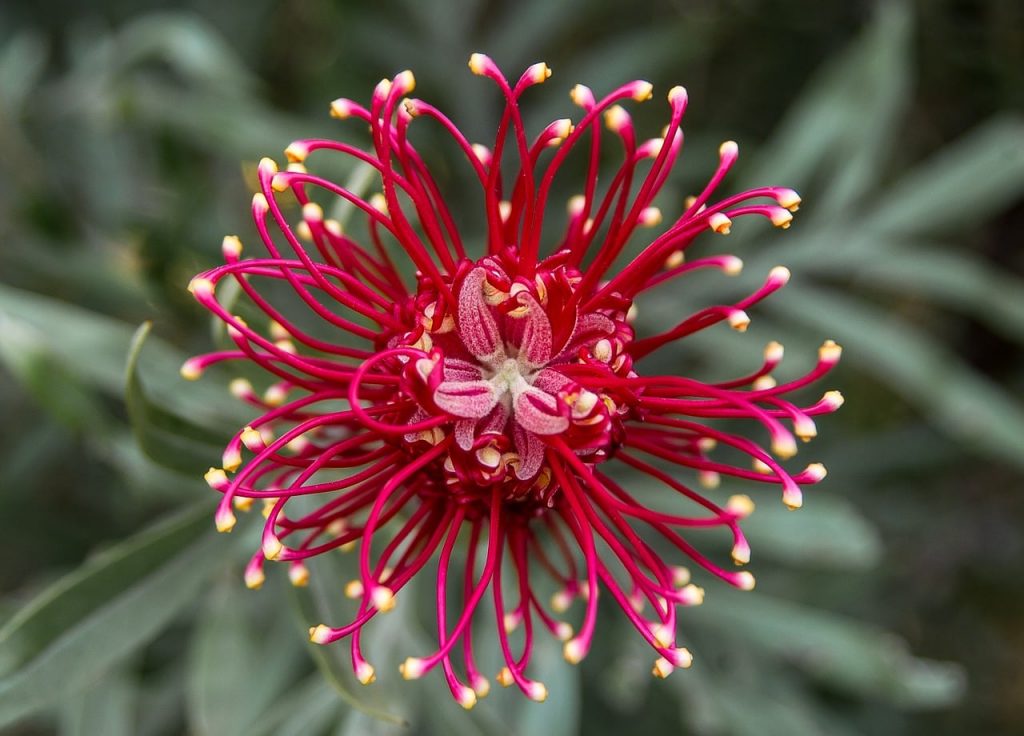
Grevillea
Try Climbing Plants
Climbing plants do require some occasional trimming and maintenance, but grow very easily and also prove resilient to extremes of temperature and dry conditions. Plants such as Ivy can add colour and character to elements such as brick walls. Be careful, however. Some climbing plants, one example being morning glories, can take over a garden. For many people, their beauty does not serve as benefit enough for the work necessary to prevent their spread.
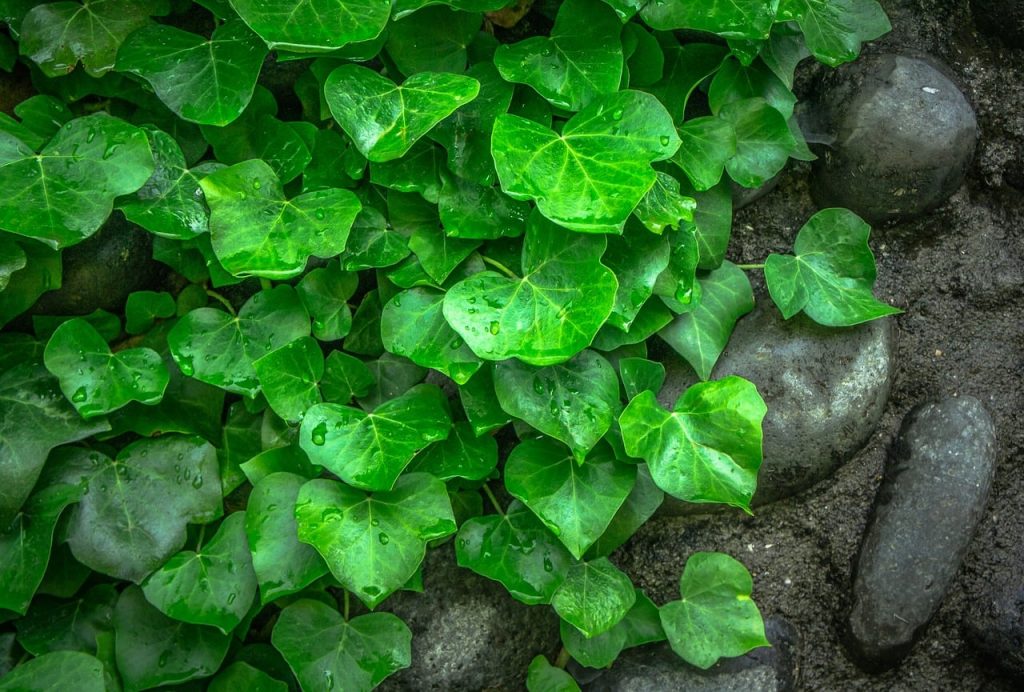
Ivy
Retain Trees, Bushes, and Other Features That Add Aesthetics and Function
Some garden designers like to go scorched earth and remove anything in the way of providing themselves with a blank palette for their designs. This should not serve as the direction for those desiring low maintenance gardens.
Many properties already have unique and interesting design features that innovative creators can incorporate into garden design plans. Old walls can serve as a base for climbing plants, as illustrated before. Trees that some may feel tempted to move can serve as shade for plant options that need less sunlight.
Even what looks like refuse can help bring aesthetically pleasing eccentricity to a garden. Old tyres in a storage shed can be painted, arranged, and filled with soil to create above-ground flower gardens, or even retaining walls. A broken wheelbarrow, barrel, or old bucket can also serve as a charming planter. Thrift shops and yard sales may also offer interesting conversation pieces that can look great in a low maintenance garden. When appropriately arranged, objects can help to create the illusion of more space dedicated to plants.
Once a gardener sees potential in non-traditional surroundings, the possibilities become endless.
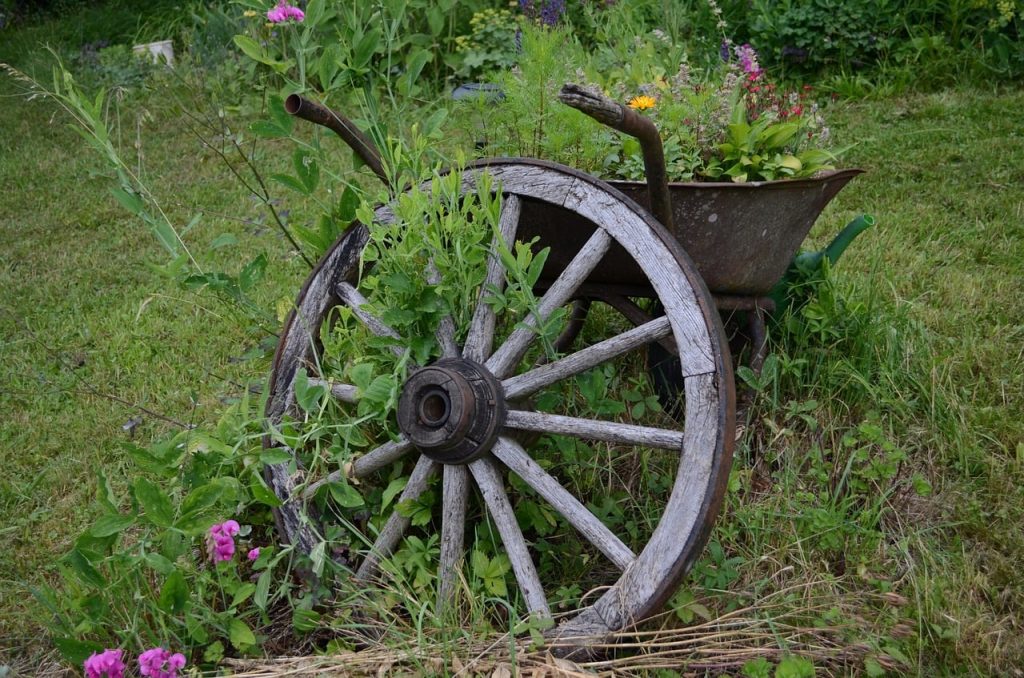
Use Stones As Mulch Over Problem Areas
Any mulch can serve as an excellent way to accentuate beauty and reduce the need for extensive amounts of work. Covering hillsides with mulch can alleviate the need to do lawn mowing in potentially dangerous or difficult areas, bringing more ease and less needed effort to lawn care.
Wooden mulch does reduce necessary time and effort. To retain its chief benefits of appearance and its ability to hold and protect moisture for roots, however, experts recommend a yearly refreshening. To hold off even that chore, gardeners can choose to use different kinds of stone instead. This can range from white gravel available at most lawn and garden shops to beautiful rounded river rocks.
Well placed and utilised stones can do all of the work of wooden mulch while requiring much less maintenance to keep fresh and useful.
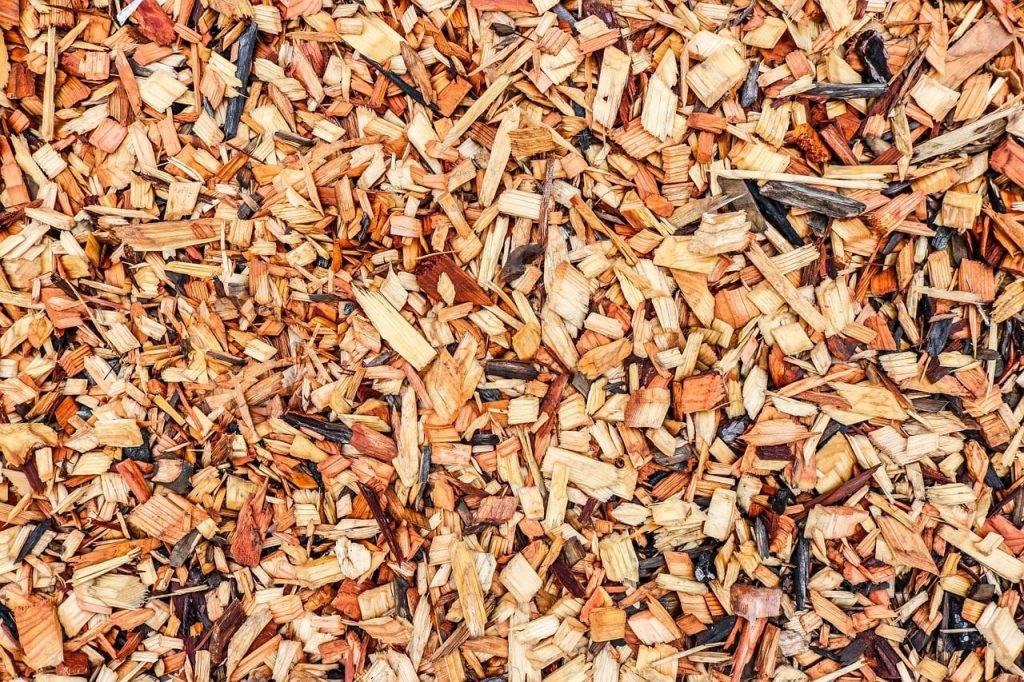
Keep the Lawn as Low Maintenance as the Garden
Good planning can help to keep lawn care and mowing to a minimum. Although the easiest way to maintain a lawn lies in paying a contractor to handle the task, one can minimise the work necessary.
First, identify areas that cause problems. These include hillsides and areas that collect water, remaining swampy even in relatively dry conditions. Soft and moist ground provides a major challenge to effective lawn maintenance.
Some techniques for making a lawn low-maintenance include mulching hillsides that present problems. Wildflowers, when properly contained, can grow in large banks that provide a near wilderness feel while providing practical and low to no maintenance cover for problematic areas.
Choosing the right type of grass, one example being zoysia, can help to reduce the need for mowing and other maintenance since it grows much more slowly. Others abandon grass altogether, choosing gravel or astroturf as ground cover that needs little or no care.
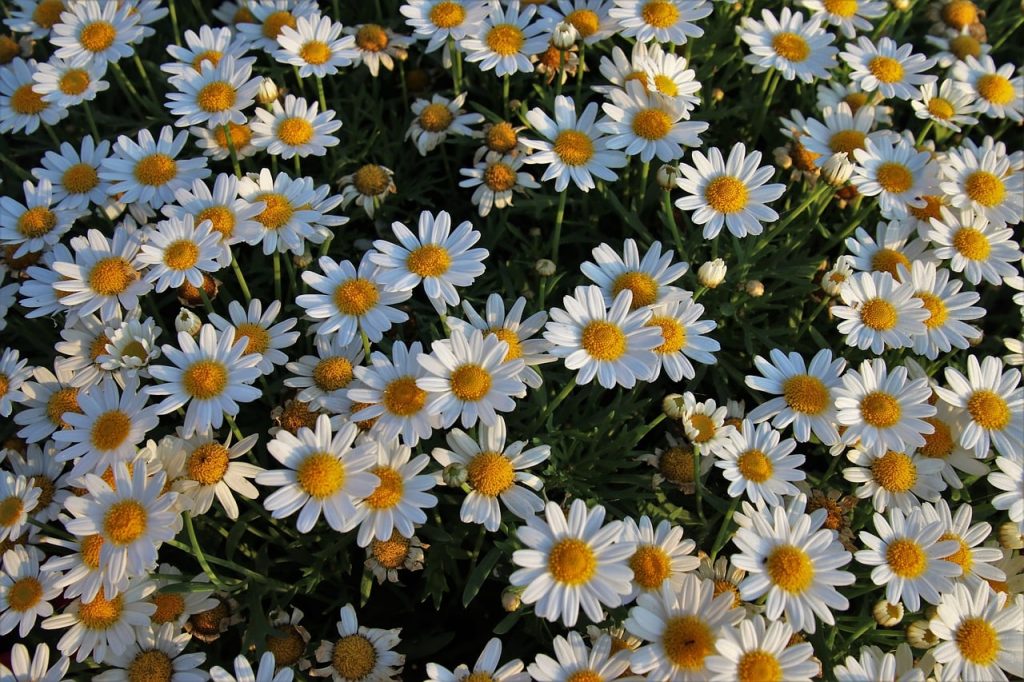
Chamomile
Start Simple in Planning and Execution
Most aspiring gardeners looking at the low maintenance approach should also restrain themselves from overambitious plans when starting out. In size, scale, and scope, the initial plan should revolve around keeping it simple. Start with a small area as almost a dry run for the first year. Plant robust native plants and take the opportunity to learn from observation and others how to make it thrive.
Another option could lie in a long term plan that foresees easily completed expansions over several years, rather than full implementation all at once.
Over time, the low maintenance gardener can attempt more risky plans, or simply expand what he or she has already done successfully. Gradual learning and development form the best path to gardening success for beginners with limited time on their hands.
Low maintenance gardening also need not be boring or dull. With the right amount of creative choices and uses of common, or easily obtainable objects, one can create an enviable product using less time, money, and even skill.
The post 6 Tips for Keeping a Low Maintenance Garden appeared first on Garden-R.
]]>The post What to Include in a Complete Garden Maintenance Plan appeared first on Garden-R.
]]>Throughout the year, experienced gardeners know that good planning and consistent work can keep the garden growing and developing in a useful and beautiful fashion. Of course the plan should also include lawn care of the land surrounding the garden to make sure that poor lawn mowing and other techniques do not detract from the overall appearance of the garden itself.
Springtime Is Garden Prep Time
When winter ends and spring rolls in, gardeners in Sydney’s Eastern Suburbs, the Inner West, and across the city, start thinking about prep work for summer.
Some of the tasks that savvy gardeners embark on as the days lengthen help to prepare the plants for upcoming summer heat and days of long exposure to the sun. Renewing mulch not only provides a fresh look, but can help protect roots and soil moisture. As lawn mowing season starts, many use this time to make any adjustments needed to their lawn care scheme.
Spring also provides the best opportunity to do tasks, such as pruning, that consume time and effort and are better done in cooler spring than in the heat of summer. This helps to promote the well-being of both garden and gardener.

Understanding How Fertilisers Help
Fertilisers can make or break a garden. Just like food that humans eat, different plants need different nutrients. Also, too much of the wrong fertiliser can lead to disaster.
Fertilisers contain active ingredients, such as nitrogen, phosphorous, and potassium, that, in the right amounts and combinations can promote excellent growth. Too much of certain nutrients in the wrong combinations has the potential to harm plants. Even worse, excessive nutrients could run off into streams and promote damaging bio pollution, while also wasting your money.
A solid garden maintenance plan takes into account the precise amounts of nutrients needed for each plant. This prevents both waste and adverse environmental impact.
Finally, many gardeners test their soil for ph levels to determine which plants will thrive naturally in the soil and which need extra assistance.
Rotate Crops in Vegetable Gardens
Beginning gardeners may not realise that certain crops can drain the soil of essential nutrients while others can restore them. Crop rotation, an agriculture basic since the Middle Ages, establishes a three area system. One area receives a plant whose growth promotes nutrient development, while two others grow crops that require what the soil can give.
Although fertiliser and other techniques can maintain nutrient levels, rotation provides the most organic and environmentally friendly approach, using nature’s own processes to keep soil productive.
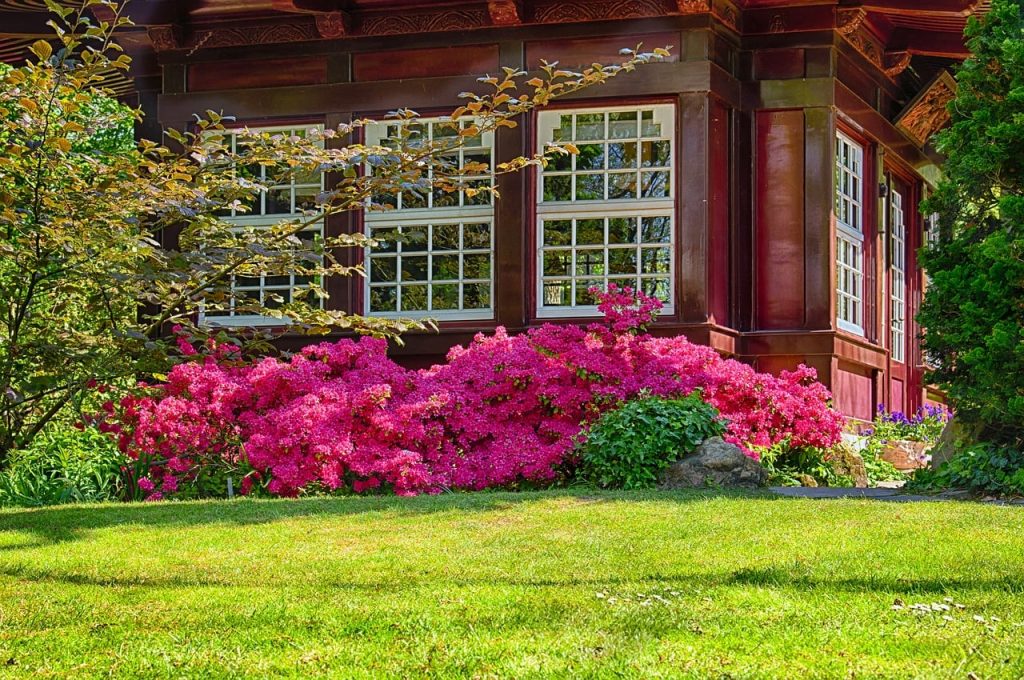
Remain Vigilant for Pests and “Pals”
Before talking about the nasty critters that can harm a garden, consider first a gardener’s natural allies in the animal kingdom. Blanket spraying of pesticides can get rid of the baddies, but also carpet bomb clusters of good guys as well. Bees, ladybugs, and other insects pollinate and in other ways contribute to plant health, not only in the garden, but also the entire ecosystem.
Some farmers even plant banks of wildflowers near gardens or greenhouses to attract bees, the ultimate gardener pal.
Other insects and critters definitely bring harm to a garden. Properly used insecticides can keep away crop killers such as aphids and mites. Gardeners can remove snails and slugs by hand or use poisonous pellets to make the job easier.
Remember that some pesticides should not be used on food producing plants. Low toxicity, systemic pesticides target the damaging insects while reducing harm to those that help.
Keeping the Garden Healthy Even in Drought Conditions
Nothing kills a garden, along with a gardener’s spirit, quite like a drought. Over the years, drought conditions are unfortunately inevitable. Droughts reduce the natural water available to plants due to the lack of rain, meaning that a gardener must work harder to make sure that the plants do not dry out. It also forces a garden to endure the relentless effects of constant sun with no break, baking the soil into a hard crust while also reducing groundwater reserves. Urban areas, and those countryside areas that rely on wells, may need to ration water in extreme instances.
Certain areas are more prone to drought than others, so gardeners in these areas need to take more care in droughtproofing their garden. Some ways to do so include:
- Researching simple water saving tips that are used in reduced rain environments around the world
- Keeping the soil healthy and using mulch around the plant and roots to retain moisture
- Choosing plants that are resilient enough to survive a potentially hostile environment. Not every plant can or should be grown in any soil type or in any climate.
Beginners Should Keep it Simple
In many cases, those just starting out in the world of gardening have cultivated ambitions and ideas for years. In their excitement to launch their garden project, they pursue complex plans that quickly put the novice gardener in the weeds, so to speak.
Beginners should do their research on plants and soils before they begin, talking to local and regional experts, looking things up online and in books, and starting with simple plants that are easy to grow. They ought to choose the hardiest and most resilient plants appropriate for the region in the first year, then slowly branch out as they gain experience. Over time, risks will be more calculated and based in knowledge and experience. Nothing overwhelms and discourages so much as ill directed effort leading to massive failure.
Keeping it simple at first increases the chance for success and the reward of a beautiful and appealing garden, and property.
These tips, however, are not exhaustive. Successful gardeners always strive to learn more, whether through research or observation. This will ensure that the garden can continue growing and evolving in an attractive, and a productive, direction.
The post What to Include in a Complete Garden Maintenance Plan appeared first on Garden-R.
]]>The post 7 Essential Tips for Maintaining the Garden During the Winter appeared first on Garden-R.
]]>Although most areas need little or no lawn mowing or lawn care, especially in Sydney’s Eastern Suburbs, Inner West region, and across the city, those maintaining beautiful gardens and properties can do a lot to make sure that it remains attractive and productive into the next growing season.
Move Potted Plants Into Cover Before the First Frost
Even before the first frost of winter settles in, gardeners should move vulnerable potted plants inside where they can receive sufficient warmth and water to stay alive during the cold months. Gardeners must take care to see that the space into which the plants get moved provides sufficient sunlight, water, proper temperature, and other necessities of survival.
Simply moving a plant from outside to a window inside may not always be enough to ensure that the plants thrive, or even survive, during winter. Make sure that the surrounding conditions support the plant and that it does not get placed too close to problems such as heaters.
Reintroduce Moisture Through Aeration
In many areas, gardens and even properly maintained yards can drain the soil of needed moisture. The main symptom of a moisture-poor yard is that it remains dry and compact even after a thorough watering.
During winter, land in such condition can benefit from aeration. Aeration involves poking a set of small holes to allow air, water, and nutrients better access to roots and soil. Extremely dry and compact ground may create conditions where water runs off and has little chance to penetrate the ground. A system of holes provides pockets to trap water and give it a better chance of soaking through to provide essential moisture for plants.
Regular aeration is vital in drier areas and places experiencing extended droughts.
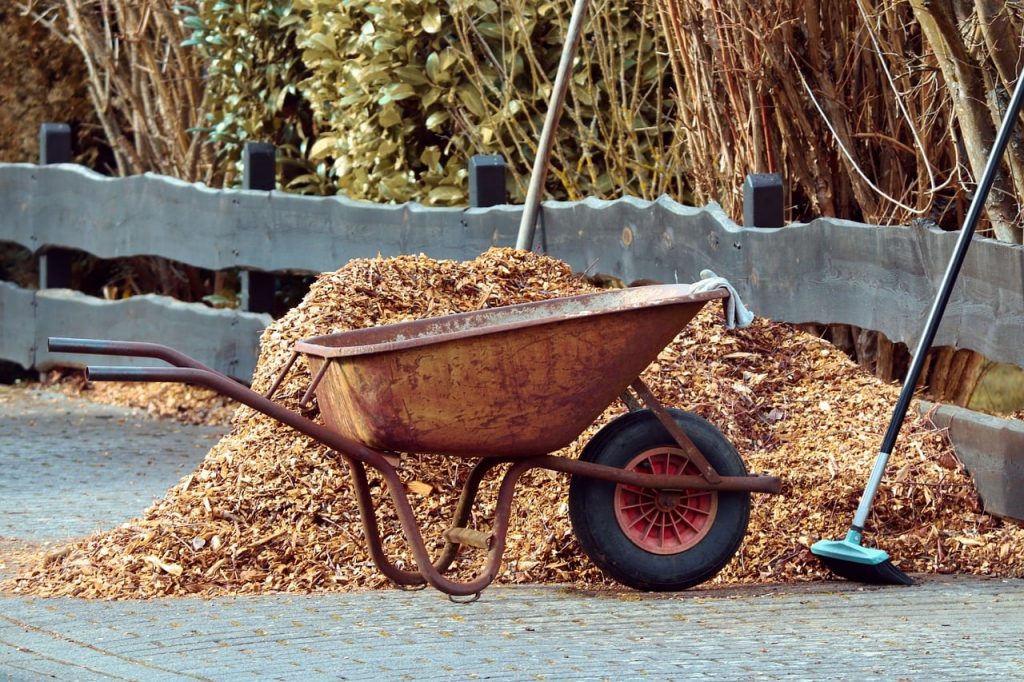
Use Winter Appropriate Feed
Less is often more, especially when it comes to fertilising garden grounds. Continuing to put high nitrogen fertiliser into the soil during low growth periods wastes resources and money. Smart gardeners and farmers practice precision fertilising. Not only does low nitrogen fertiliser allow soil to rest, it also prevents the leaching of polluting and unnecessary nutrients into streams.
Be Careful When Pruning in Winter
Winter can provide the perfect time to prune and perform hedging tasks, at least with the right plants.
Deciding whether or not to prune in winter depends on both the plants and the climate. For example, many choose to prune roses in the winter in all but the coldest regions. If desired, prune down to the three or four main stems to allow more lush and full growth later.
Other plants that welcome a winter pruning include hydrangeas, wisteria, grapes, and gardenias, among many others.
When in any doubt, consult local experts to determine the best course of pruning action in winter months.
Plants That Can Thrive In Winter
For areas that see cooler temperatures, but without overwhelming amounts of frost and snow, gardeners can plant a number of options that can provide food and beauty in months when many do not even think about gardening.
Available flowering plants in many areas include golden wattles, native fuschias, and banksias. Some peach trees may even flower during August in the late winter. Food cultivators often favour hardy plants like strawberries, peas, spinach, potatoes, broccoli, and others. Winter also provides a great opportunity to tend to edible plants that can thrive inside, such as oregano, thyme, and garlic.

Great Time to Finish All of the Necessary Odd Jobs
Even in the coldest areas, active gardeners can still tend to the maintenance of their grounds. Winter provides an excellent opportunity to implement new garden designs and perform garden maintenance. Gardeners can take advantage of dry and cool (but not freezing!) days to get their land in order so that their garden can achieve its full potential in the coming growing season.
Some essential tasks include:
- Checking and shoring up fences and walls
- Cleaning out of trees or bushes marked the summer before as needing removal
- Cutting down of weeds and other overgrown areas
- Add drainage channels in areas that tend to collect too much groundwater in the warmer months
- Feed any citrus plants by late July, using specialised fertiliser
- Plant asparagus, rhubarb, strawberries, and other plants that require winter planting
- Start inside germination of plants needing to go into the ground in spring, including tomatoes and other food producers
Certainly, many of these tasks, outside of the plant specific, can be undertaken in the spring, summer, or fall. Winter, however, has ample days with optimal temperatures for moderate to heavy labour, such as digging, construction, and other important tasks.
Some Pests Do Not Disappear in the Winter
Unfortunately, some garden pests continue their relentless assault during even the cooler months. Especially for those living in areas that do not see frequent frosts and cold temperatures, aphids and other usual suspects will still create problems. While chemical pesticides can be effective, those going the natural route can also perform such home tricks as placing a glass of beer near the garden to attract and drown pests attracted to its natural sugars.
Plants that repel some pests, such as onions and roses, can also help repel pests when placed strategically around the garden.
Winter is time for much of the natural world to rest, but not the avid gardener. Tasks still potentially abound throughout the winter months for those trying to keep their grounds in tip top shape to reach maximum potential throughout the growing season.
Year long effort will make sure that your garden shines its brightest in summer.
The post 7 Essential Tips for Maintaining the Garden During the Winter appeared first on Garden-R.
]]>The post 10 Ways to Avoid Lawn Service Scams appeared first on Garden-R.
]]>
You’d be gobsmacked to know that even for the same company, a lawn mowing service franchisee might quote you a huge variance in services and costs.
In addition to this, the lawn service industry isn’t spared when it comes to scammers who use legitimate guises to get people’s money. In fact, a lawn care company in the US was required to refund more than $78,000 to consumers after providing overpriced lawn care services to senior citizens. The scam involved door-to-door solicitations and deceptively providing consumers with services without disclosing the total amount prior to the transaction.
Of course, not all lawn care providers who will offer you their services are scammers. But to be sure that you’re getting your money’s worth, it’s best to take precautions. Especially if you’re spending hundreds or even thousands of dollars for lawn care service, it’s better to check first if you’re entrusting lawn care to experts.
Before deciding on a lawn contractor, here are some pointers that you should take into consideration:
- Ensure that the company is a reputable business
Always check who you’re dealing with. Lawn care service scams should be a wake-up call to those who simply hire providers just to get the job done and without doing research. Don’t outright trust flyers and door-to-door services without checking first if the lawn care business is legitimate.
If you’re not keen on doing a thorough background check yourself, at least ask for referrals and feedback from friends and neighbours. You could also get an idea about the service and cost by asking around.
You’re entrusting so much more than your lawn and garden to lawn care providers. In some cases, you’re allowing them inside your property and giving them access to expensive equipment. Plus, if you’ve invested so much on your lawn, it’d be a total waste if you allow people without training and experience to work on your plants.
- Look for experienced and trained providers
Some lawn care service providers might have no formal training or experience when it comes to the business. But lawn care is more than just mowing services, fertilising plants and pruning trees. Asking for a licensed agronomist on the team may be too much, but it’s necessary to check if the company has a legitimate background and experience when it comes to gardening.
Check the background of the key people in the business. Ask if the staff undergoes training about plant care, standard practices and safety techniques.
You can also check if there’s an expert advisor or consultant on board who has enough knowledge about plants, landscaping and gardening. Hiring an expert shows that a lawn service company is serious about doing business and providing quality and expert service.
- Check for online presence such as feedback and reviews
Having an online presence is another sign that a lawn care service isn’t a scam. It shows that the company’s committed enough to provide a good site that has information on their products, services and pricing. You could also get more information about the lawn care service company, such as its year of establishment, its key people, customers and projects.
Online reviews are also worth checking. Though this isn’t always reliable, you’d get an idea about the company by reading a couple of positive and negative reviews.
- Ask about previous and current clients
Before committing yourself to doing business with a specific lawn care provider, check their previous and current work. It would be reassuring to work with experts who have enough experience on projects. You’d also want to know how they get the job done, so you can have ideas on how to better improve your lawn.
- Check if there’s a customer care service
Not all lawn care providers have customer care service options but a company that’s easy to contact is a sign that you’re dealing with a legitimate business. It’s also more convenient to do business with providers if you can easily contact them. You can quickly schedule sessions, make adjustments, ask for products and services and make general inquiries.
- Review the certifications and registrations
Certifications and registrations can help you distinguish the legitimate lawn care providers from bogus ones. Certified businesses are usually members or are recognised by lawn industry associations.
Certifications are also required for lawn care services that provide fertiliser application and pest control since they’re dealing with potentially dangerous chemicals.
- Inquire about insurance policy
It’s best to do business with lawn care providers that provide insurance. They should, at a minimum, have liability insurance in case something goes wrong. It rarely happens but sometimes equipment problems and accidents may happen. A legitimate company should at least be prepared for such unforeseen occurrences.
- Review the lawn service contract
Before the deal is closed, review the contract thoroughly. The contract should include details about the extent of work, timetable, cost and terms of payment. A contract ensures that both you and the service provider have a clear understanding of the extent and cost of the job. This prevents hidden chargers and unexpected costs that you have to deal with once the deal is closed.
- Compare offers
Shop around and ask for deals and discounts. Ask whether the lawn service company has their own equipment or whether they’ll be using yours. Look for bulk options and avoid per hour services if possible since you’d generally save more money.
Check for the type and extent of services offered as well so that you don’t have to hire another company for other tasks on your lawn.
No two providers are the same and even little savings for a top-notch service can save you a lot of trouble along the way.
- Look for aftercare options.
Having aftercare options from your lawn care provider is helpful. This could ensure that your lawn care service provider wouldn’t simply rush the job as the aftercare would be costly for them. A lot of factors come into play even after having experts care for your lawn, such as growing conditions, type of grass, soil quality and shade. It’s reassuring if you can get aftercare services from your lawn care provider.
A Bad Experience Should Not Discourage You
Initially, you might not even know that you’re paying more for the services you’re offered. That’s why it’s best if you ask around and inquire first before doing business with lawn care providers in your area.
Some people who probably got scammed by fake lawn mowing service providers take things into the extreme and might have opted for the $3,000 lawn mowing robot instead. Still, you shouldn’t completely lose faith in humanity.
Landscape maintenance and care from expert providers are less costly—they have their own equipment and are more skilled when it comes to taking care of your lawn. And of course, robots don’t have the green thumb that lawn mowing experts and gardeners have. Hiring experts ensure that your lawn is well trimmed, taken care of and healthy all year round.
Choose the Best Lawn Care Service Provider
It’s not enough that you know that you’re dealing with a legitimate lawn care service provider. You can hire services for half the price from job boards, but this doesn’t ensure that you’ll get the expert service that you’re looking for. Here are some tips you should consider when looking for the best lawn mowing service:
- Choose a lawn care service that offers complete service. Check if the company provides not just lawn mowing but also cleaning, aeration, weeding, fertilisation and pruning if necessary.
- Consider companies that offer quality fertilisers. You can also inquire about organic fertilisers.
- Prioritise companies that cater in your location.
- Look for packages that can help you save on lawn mowing cost and services.
- Choose companies with known track records that provide expert service.
If you’re looking for regular or long-term lawn mowing service, here are some tips that can help you decide whether you’ll stay with your current lawn care provider or look for other companies:
- The staff arrives on time and at the actual schedule.
- The service provider works quickly and efficiently.
- The company uses safe, quality and up-to-date tools and equipment.
- Safety is prioritised at all times.
- Their people have working knowledge on the types of grass, plants and terrains.
- They are pleasant and professional to deal with.
- They share tips and offer advice on how to take care of your lawn.
- They provide quality work that significantly improves your lawn.
Do Your Research and Hire Expert Lawn Care Providers
You must do your research so that you won’t become a victim of scams. You should also compare prices so that you would have an idea about the rates and services offered in your location. Although this might be time-consuming at first, this effort will pay off after hiring the best lawn care service in your area. You wouldn’t want to pay so much for just substandard work. If you trust lawn mowing service contractors that won’t be able to do the job properly, your lawn might look like a disaster and you could end up paying more just to fix the problem.
The post 10 Ways to Avoid Lawn Service Scams appeared first on Garden-R.
]]>The post How Many Calories Does Mowing the Lawn Burn appeared first on Garden-R.
]]>
Calories Burned in Lawn Mowing
According to Captain Calculator, if you weigh 73 kg, you will burn 96 calories in 30 minutes of riding a mower. For a light or moderate effort in a power mower, you will burn 172 calories in 30 minutes. With moderate or vigorous effort in a walking or power mower, you’ll burn 192 calories.
You’ll burn the most with 230 calories in 30 minutes by using a hand mower. That’s a lot of total calories burned compared to the 77 calories you’ll burn if you stroll slowly for 30 minutes.
Health Benefits of Lawn Mowing
Lawn mowing is a form of aerobic and resistance exercise. Your heart and lungs work harder when you do an aerobic exercise. Aerobics also helps you work out your entire body as you move. Meanwhile, resistance exercise makes you work against gravity.
With lawn mowing, you perform aerobic and resistance exercise. If you use a manual push mower, you walk continuously and also use the mower to resist the grass and slopes on your lawn.
The best forms of exercise are those that you routinely do. Lawn mowing is a good form of exercise if you don’t want to exert extra effort by going to the gym, or if you think that jogging and swimming are not for you.
Frequency of Lawn Mowing
To keep a healthy lifestyle, you need a total of 150 minutes of physical activity in a week as recommended by the Centers for Disease and Control Prevention. If you want to make lawn mowing as your primary form of physical activity, you need to have to mow your neighbour’s lawns, too! In addition to lawn mowing, you can also prune shrubs and rake leaves as forms of physical activities. You can burn those calories as you wait for the grass to grow again.
Stay Active by Going Outdoors
If your day is packed with commitments and you laugh at the notion of spending time at the gym or running, it doesn’t mean that you can’t work out every day. You can use everyday activities, such as lawn mowing, as part of your routine. Find out activities that you genuinely enjoy and can help you burn calories at the same time. Look for ways that can make these activities more challenging to increase the amount of calories you burn.
You can burn calories and build strength by going outdoors. As much as possible, don’t hire out all your lawn work. Gardening makes you get up and down, stretch, and bend. You can burn calories by raking and bagging leaves, using your hand-held clippers, and by doing other gardening activities.
The post How Many Calories Does Mowing the Lawn Burn appeared first on Garden-R.
]]>The post How Much Does Lawn Mowing Cost appeared first on Garden-R.
]]>
Are Lawn Mowing Services Worth It?
Hiring a lawn mowing service is ideal if you’re too busy to maintain your lawn. A lot of work goes into lawn upkeep and you’d be surprised at the amount of time that goes to keeping your lawn perfectly well-trimmed. If you don’t have time to work consistently on your lawn, it’s best to hire a lawn mowing service so that you can spend more time doing other activities.
If lawn mowing is a chore for you and you’d rather have other people do the task, you may wonder how much lawn mowing services cost.
Cost of Lawn Mowing Service
You can pay a teenager to mow your lawn for $17 per hour but this doesn’t equate to a professional service. On average, a lawn mowing company charges about $40 per hour while others may go as low as $25 or $100 depending on the services included in the package.
A one-time lawn mowing service may charge you $100 but for regular trimming services (e.g., monthly), you can save $10 on average. Ride-on lawn mowing service charges a bit steeply at $130 on average.
Landscaping contractors provide different types of services such as lawn upkeep. Here are some of the common services offered by contractors:
- Tree trimming
- Lawn aeration
- Weeding
- Seeding
Cost of Tree Trimming
Tree pruning or trimming is an overlooked detail in terms of lawn care. But this should not be the case because trees add to the overall appeal of your lawn. Pruning ensures that there aren’t any dying branches. This practice also helps the overall health of trees as it stimulates growth.
Different factors affect the cost of tree trimming or pruning. The size of the tree and its species may affect overall cost. Pruning cost ranges from $500 to $2000. But for pruning smaller trees, $50-55 dollars is the usual hourly rate.
Cost of Lawn Aeration
Lawn aeration is essential in keeping your lawn luscious. Your lawn can lose its appeal overtime, so aeration is needed to invigorate the grasses. Lawn aeration helps the grass to breathe by dealing with thatch and compacted soil. By breaking up compacted soil, water and fertiliser can permeate the root zone. On average, the complete aeration cost is $175 dollars but this may change depending on the size of your lawn and other factors.
Cost of Weeding Your Lawn
Lawn care companies offer different lawn mowing packages. Traditional weeding packages involve the use of fertilisers to kill weeds. But other companies offer the use of safe organic programs to eliminate weeds without possible harm to people, pets and other plants. If your lawn is in a bad shape, you’d have to spend $100 on average for weeding. And this price doesn’t cover garden cleaning service which may cost you around $70.
Cost of Seeding Your Lawn
If your lawn is damaged, reseeding is another way to ensure that your lawn is healthy. Prices may vary due to certain factors but the average cost of lawn seeding for a 100 m2 lawn is $100-200.
Tips on Choosing a Lawn Mowing Service
Get quotes from local companies that offer lawn mowing and other gardening services. Here are the factors that they’ll consider for the cost.
- Size of your lawn
- Types of services offered including weeding, edging and adding fertiliser
- Terrain, slopes and other factors that might make lawn mowing difficult
- Experience and expertise
- Location
The cost for lawn services varies based on the size of your lawn (i.e., whether it’s residential or commercial), so the bigger your lawn, the more you have to pay for services.
It’s better if you get quotes per job done than per hour. An experienced lawn mowing service will have better equipment and more experienced staff, so the job can be done faster and more efficiently.
Alternatives to Lawn Mowing Services
Having your patch of perfectly trimmed grass is wonderful, but a lawn needs to be water intensive and requires constant mowing and weeding. But if you think that the cost of lawn mowing service is too much, there are other affordable alternatives.
- If you can’t imagine not having grass on your lawn, plant a slow-growing grass. Low maintenance grass like Zoysia, which is commonly found in golf courses, are hardy during intense drought and ideal if you’re not looking forward to mowing often.
- You can ditch the grass and put other creeping plants on your lawn to get the same effect. Kidney weed and woolly thyme are plants that are great groundcover. Woolly thyme flowers once a year, is drought tolerant and can handle the sun.
- Plant a garden or use gravel. Low plants can serve as good groundcover and look pleasant. Native grasses like kangaroo grass grow well. Using fine enough gravel that provides a spot to walk on around the garden beds is another alternative.
- You can get rid of the grass and simply use synthetic grass. This is ideal for areas that easily get trampled. Another advantage is you won’t have to mow or water the grass. Synthetic grass may cost you about $30 to $100 per square metre and may set you back around $100 per square metre of installation. But synthetic grass doesn’t require expensive upkeep and are more resilient than natural grasses.
Find the Best Lawn Care Company
Although you can care for your lawn on your own, it’s more practical to hire someone else for the job if you don’t have much time and energy to spend your weekend caring for your lawn. If you need help, contact a local landscaper. Professional lawn mowing services have the tools and expertise to help maintain the beauty of your lawn.
The post How Much Does Lawn Mowing Cost appeared first on Garden-R.
]]>The post Best Lawn Mowing Tips and Tricks appeared first on Garden-R.
]]>
If you’re to spend your weekend under the sun mowing grass, instead of resting and relaxing, you wouldn’t want to waste your time by messing things up. Knowing the best way to mow your lawn can make the process quicker and more painless.
Making your lawn look good depends on a number of factors, such as the mowing height and frequency. If you want to ensure that you’re on the right track towards cutting-edge lawn mowing, follow these tips and tricks to get things right.
Choose the Right Mower
If you’re thinking of getting a lawn mower or you’re planning to replace your old one, choose equipment that’s right for the job. For smaller lawns, choose a reel lawn mower as it’s less noisy and easier to use than typical gas mowers.
The power mower is more ideal for large lawns because of its grass catcher and mulching functions that help save clean-up time. And for larger lawns—that have at least 0.41 hectares—a riding mower will make the job easier. But riding mowers are more costly and aren’t safe to use in steep hillsides.
If you’d like to take things to the next level, choose a battery-powered mower. This mower doesn’t burn gasoline oil, so it’s quieter and more environmentally friendly.
Ensure that Your Mower Blade Is Sharp
Regularly check the mower blades for any signs of wear. Ideally, have your mower tuned up and sharpen the blades for the cleanest cut at least once a year. Visit your local hardware store to have your blades sharpened.
You’ll waste your time with a poor cut if you use a dull blade. Also, using dull blades can weaken the grass, making it susceptible to pests, diseases, and other damages. Clean your mower after each use to prevent blockages.
Remember that it’s not safe to add fuel to warm engine, so check the fuel level before you start mowing. Change the oil and clear the fuel lines as necessary, or have professionals check this for you before you mow. Oil the moving parts if you think they’re tight. Check if your lawn mower has warranties and free tune-ups.
Clear Out Debris
Inspect the yard and remove anything that’s not grass—like rocks, sticks, toys, or golf balls—with a rake. For low-lying obstacles that can’t be moved, such as pipes, make sure to mark their locations. This will prevent you from running over them, and the blades on your mower will stay sharp.
Mow When the Grass Is Dry
Ensure that the grass is dry before beginning to mow. Wet grass because of dew can make lawn mowing more difficult. The wet grass will clump and clog the discharge chute, which is the flappy part on the mower’s side. Your tires won’t get a good traction, so lawn mowing would just become a hassle.
Wait until the grass is fully dry. You can time your sprinkles late in the night, so there’s no moisture on the grass in the morning.
Don’t Overcut
If you overcut your lawn, the grass will thin out. They will be more vulnerable to temperature changes and weed invasion. Don’t make lawn mowing a weekly ritual. Rain, temperature, and the type of grass are some of the factors that affect the growth of grass.
With that said, here’s what to do: set your mower to trim just a third of the grass length. Maintain an ideal lawn height to keep the grass healthy after lawn mowing. The buffalo grass should be at least 40 mm to 50 mm. Kikuyu should be at least 40 mm. Couch grass should be 30 mm. Keeping an ideal height ensures that the grass can hold more water.
Most grasses have a recommended cutting height. Set your lawn mower at the upper range during stressful conditions, such as drought. You can cut the grass a little lower when the weather is a bit cool.
Mow Around the Perimeter First
Prioritise mowing along the perimeter of your lawn. Go over obstacles and trees, and follow straight lines and angles around such areas. Mowing around the perimeter ensures that you’ll square off the lawn. You’ll have more room to turn as you move back and forth.

Follow a Mowing Pattern
Don’t mow in a spiral direction. Use a back-and-forth pattern to come up with neat and even rows. Mow in half-lap passes. The new pass should overlap the earlier one by half the mower width. This technique ensures that you’re not missing anything on your first pass.
You can also make a checkerboard pattern on your lawn. This is the pattern you see on a sports field. You can create this pattern by using the lawn mower to bend the grass. The grass that bend towards you are darker than those bent in the opposite direction. Mow in a straight direction along the edge of your lawn. Turn around and mow straight the opposite way. Alternate your directions until you finish the entire lawn. Then, turn 90 degrees across your lawn, and move in alternating directions.
Note that you should change the direction of your rows to prevent the grass from bending permanently in one direction. This technique also prevents leaving track marks to the grass.
Take Your Time
Although mowing may not be your favourite activity when the weather is fine, you still need to take extra care when cutting the grass. Taking your time makes a lot of difference when it comes to maintaining a lawn. If you speed around to get things done faster, you’ll get an uneven cut. You can follow a moderate pace, just like your speed when you push a grocery cart.
Practice Edging and Trimming
Edging and trimming are considered as the finishing touches of lawn mowing. Edgers are tools you need to trim hard surfaces, like the sidewalk and driveway. Meanwhile, you can use trimmers in tight spaces, such as planting beds.
Some people prefer to edge and trim first before mowing. This can also work because the clippings are spread out by the lawn mower. Still, you need to be careful when trimming or edging because this practice tends to be harsher to the grass than mowing alone.
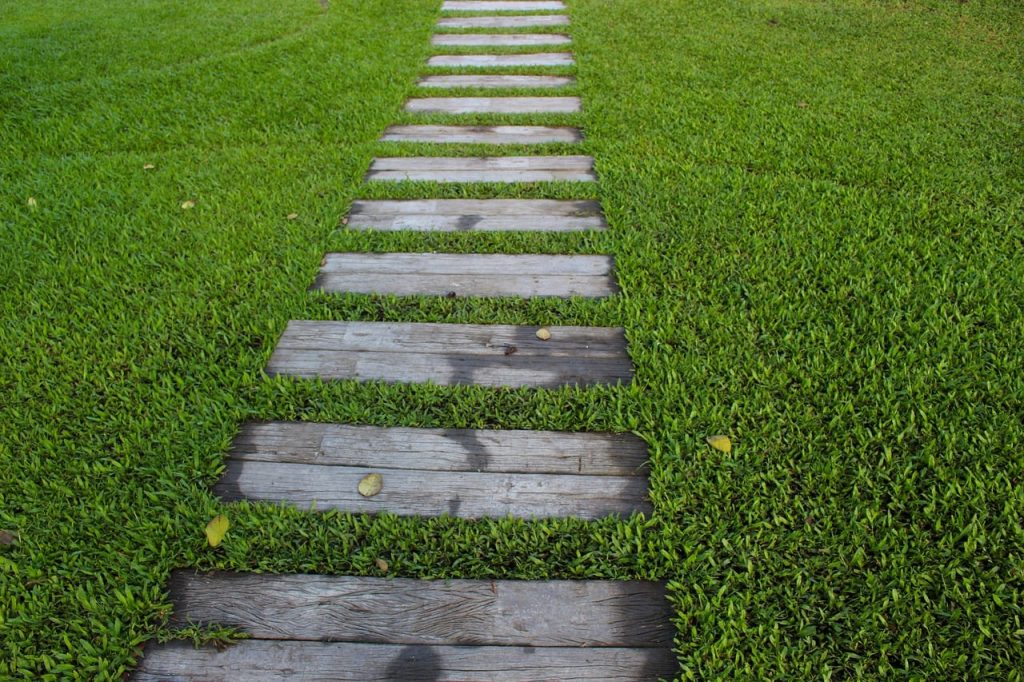
Don’t Throw the Grass Clippings Away
You can use the grass clippings as organic matter because they’re rich in nitrogen, potassium, phosphate, and other nutrients. This will also save you time and energy from cleaning. You can simply leave clippings where they are. They will break down quickly and decompose. Contrary to popular belief, the clippings won’t form thatching, which is a layer of partially decomposed grass.
Protect the Trees
Frequently mowing near the trees can damage the bark and tissues. This can prevent the tree from growing further, and the trunk may become very weak and easily snap off. Protect the tree by leaving at least 0.3 metre wide of undisturbed space around the trunk. Place an edging around the tree and cover the space with mulch or compost. You can also visit your local hardware store and look for products specifically made to protect trees.
Lawn Mowing Safety Reminders
In addition to the lawn mowing tips, here are some useful safety techniques that you should keep in mind:
- Familiarise yourself with the equipment. Check the user’s manual. Understand the safety features. Keep the lawn mower in tip-top condition.
- Always move in the forward direction when you’re using a push mower.
- Move from side to side when mowing on a slope to prevent slipping. Be careful on steep slopes because you may lose control of the lawn mower.
- Prioritise safety by always wearing closed shoes, and not sandals or flip-flops.
- Wear sunglasses or protective covers to ensure that debris won’t hurt your eyes while you mow.
- Lawn mowers may be extremely noisy. Trimmers, edgers, and blowers tend to be noisy too. Protect your hearing and wear ear plugs, if necessary.
- Make sure that there aren’t any children or pets around you.
- Stop the mower when fuelling. Never fill the lawn mower with excessive gas, and always clean up spills.
- Turn off the lawn mower when it’s not in use.
Benefits of Mowing
You may think that mowing is too easy. But it’s a skill that can be useful when done right. Mowing helps grass grow better and keeps your lawn in tip-top condition. Get the best type and brand of lawn mower that’s best for you, so you’ll easily finish the task. Make sure as well that you’re following the best practices of lawn mowing—always avoid mowing grasses too short, using dull blades, and cutting too much grass at once.
The post Best Lawn Mowing Tips and Tricks appeared first on Garden-R.
]]>The post Top Tips When Planning a Vegetable Garden appeared first on Garden-R.
]]>While nothing beats learning by experience, planting a vegetable garden does take a bit of planning and knowledge. If you want to be fully prepared before you start digging, read on to know more about what you have to consider when planning a vegetable garden.
Location of your vegetable garden
Location is one important factor that will determine if your vegetable garden will thrive or not. Some details to mull over when planning where to build your garden include:
- Aspect
You have to figure out which side of your property provides a healthy amount of sunlight. Typically, the south side gets all the sun.
As vegetables need about eight to ten hours of sunlight during the growing season, you have to determine which area in your garden will provide that amount of sun exposure.
Once you get the sunlight direction in check, think about the soil. Is there soil on the south side of your house? Or do you need to bring it in through a raised bed? You could always adjust how you will plan for the soil, so prioritise sun exposure over what is on the ground.
- Slope
Consider yourself lucky if you have a hillside area that’s open and sunny. That could be a great place to grow your vegetable garden! But if you don’t, again, it’s best to choose an area that gets enough sunshine for most of the day.
- Water Source
When you’re deciding on location, you also need to think about water source. Maybe your slope is ideal for sun exposure but you’d need to fix the water pressure. Or maybe what you originally intended is too far from the house after all. Make sure your water source is accessible when planning where to put your vegetable garden.
Bed Design
The location largely determines what style of planting system would be ideal for that space. You could go for raised beds, traditional rows, or square-foot gardening, to name a few.
While each planting style has its own advantages, a raised bed garden generally provides more control and ease when it comes to protecting, watering and keeping your vegetable plants weed-free.
Whichever style you opt for, it’s recommended to set about 1.2-metre-wide garden beds. You could choose how long the beds are going to be, just leave at least 60-centimetre pathways between the beds. This way, you could tend to the plants without needing to step on the soil and compacting it.
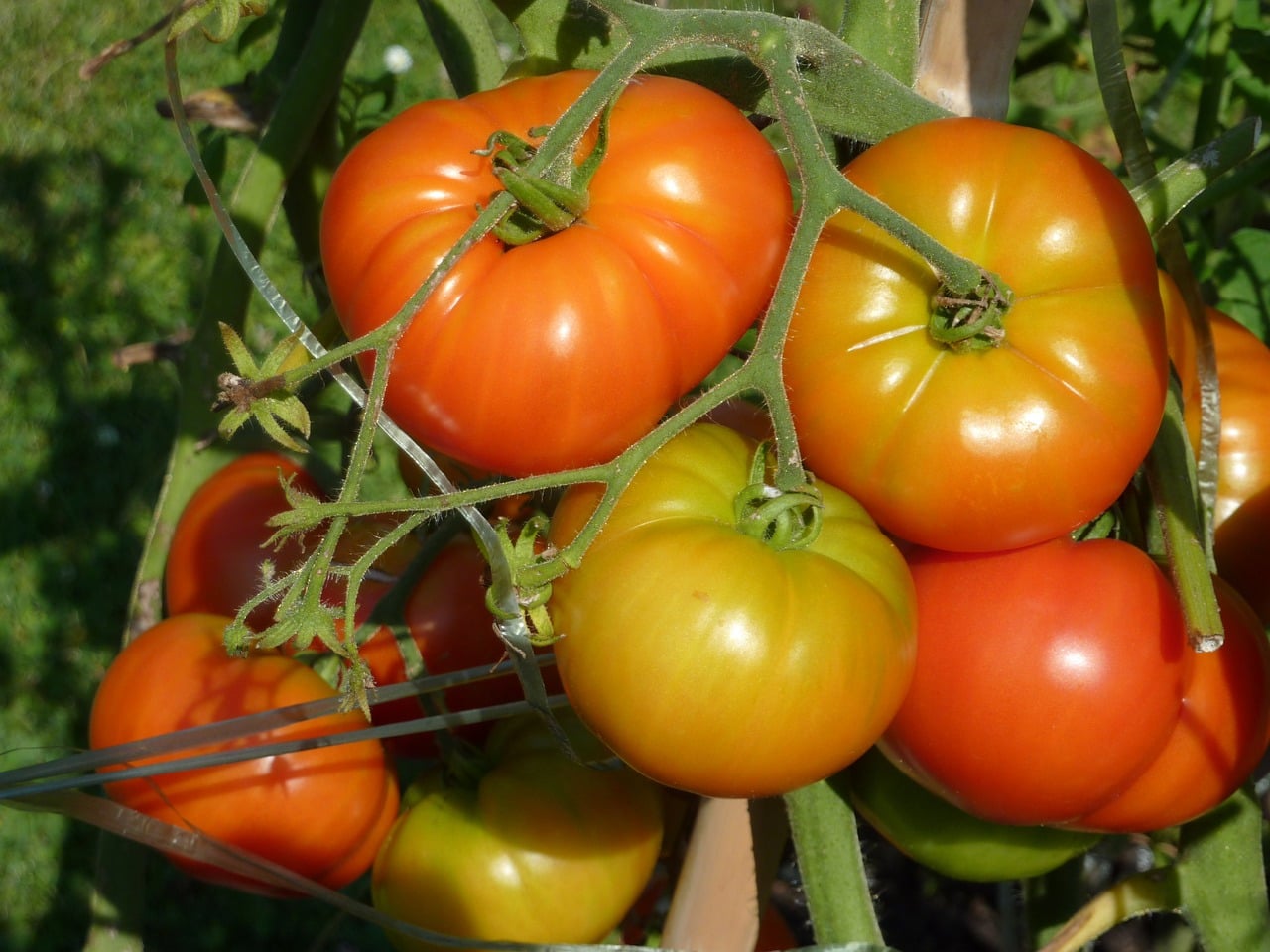
What to Grow in a Vegetable Garden
With so many vegetable varieties, it can be difficult to make a decision about what to put in your garden.
To make the process much easier, here are some general rules worth knowing:
- Tender plants
Plants such as tomatoes, peppers, eggplant, basil and herbs are the most delicate ones, so reserve your sunniest spots for these crops. The nice thing about these varieties is that they give you abundant produce continuously.
- Roaming/climbing plants
While your tender vegetables are positioned front and centre, you’d want to place vines like melon and squash right at the edge of your beds. This prevents their broad leaves from covering your other plants, and lets them spread out on the sides. You could use fencing to train the vines to climb and take any direction you would want.
For vegetables that climb up—peas, beans and cucumbers—try planting them on the northern part of the bed so that they won’t shade your other veggies.
- Perennials
Plant your perennials, like berries, artichokes and asparagus, separately so you could rotate the other varieties while leaving the perennials undisturbed.
- Companion planting
Planting a variety of crops in one bed confuses pests and reduces the chances of attracting them. Hence, consider mixing it up and avoid planting large areas of a single crop (or crop family).
The only exception to this rule is when the plants require a protective netting, like the ones used for cabbages, broccoli and cauliflowers. These you should grow together.
- Insect-attracting plants
If you want to protect your crops from pests and aid pollination, try adding varieties that attract beneficial insects like bees and ladybugs. Some examples include onion, garlic, chamomile, daisy, marigold and a whole lot more.
- Timing of harvest
Maintaining your vegetable garden means harvesting as much as tending to it. Hence, you have to consider if you are around the entire week, or if you are only around on weekends. Tomatoes could still be harvested when overripe, but beans could grow in an instant. Plan what you will plant according to your harvesting schedule.
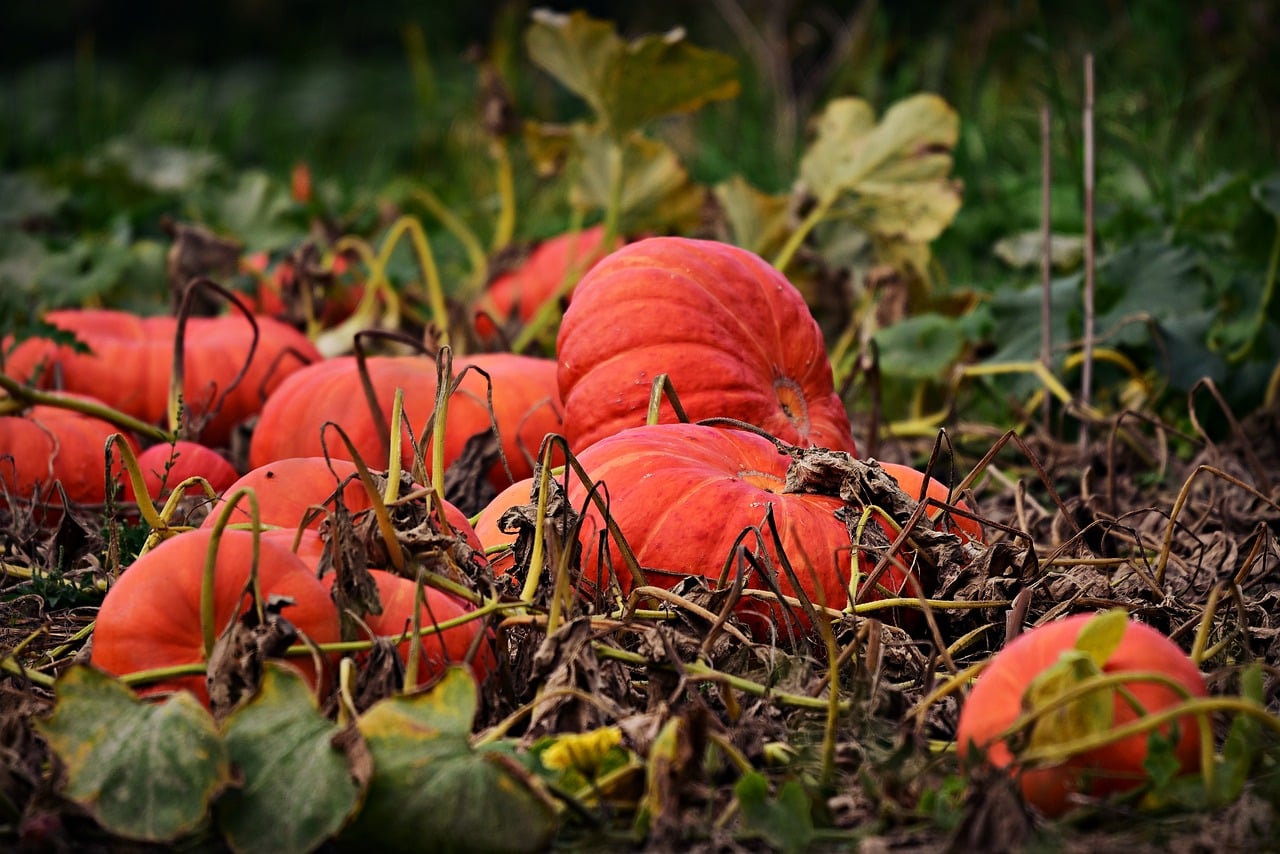
Number of plants
Vegetable gardens are quite exciting to plan, as you immediately think about what kinds of produce you will have regularly. But as tempting as it may be to add a lot of different crops, it’s important not to overcrowd the plants.
Planting too many varieties could compromise the quality of their growth. So, keep in mind that seedlings may look small now, but in a few weeks, they will grow and fill your space. Always leave enough space in between your vegetables.
A vegetable garden is a nice addition to any property. And for beginners, there are a lot of things to remember, which can be quite overwhelming. Given these key considerations, you could start planning where to put your garden, what type of construction you will need, and which crops to prioritise.
If you are interested in growing a vegetable patch, Garden-R can assist with the planning and planting process. With us, you could use these principles to design a garden that is perfect for your outdoor space.
The post Top Tips When Planning a Vegetable Garden appeared first on Garden-R.
]]>